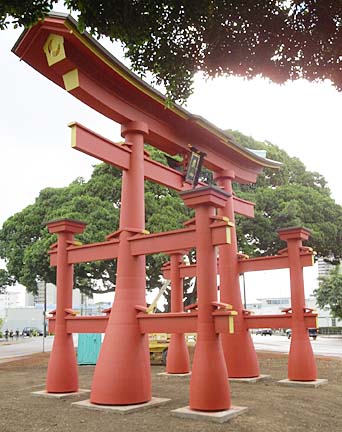

Raising Cane
By Rob Perez
Sunday, October 28, 2001

It's supposed to be a symbol of friendship between two communities, a gift given by one to the other as a gesture of good will. Japanese gift ruffles
feathers in HonoluluIt's turning into a symbol of controversy as well.
Questions are being raised about why the city is spending $165,000 to erect a large torii gate on the traffic island where King and Beretania streets meet in Moiliili. The cost also covers landscaping.
Although the people of Hiroshima, Honolulu's sister city in Japan, gave the torii as a cultural gift to Honolulu, it is considered the principal symbol of the Shinto religion. Torii gates are found at Shinto shrines and represent the entryway into sacred grounds.
"If there ever was an emblem for Shintoism, it's the torii," said George Tanabe, a University of Hawaii professor of Japanese religions.
The Rev. Daiya Amano of Izumo Taishakyo Mission of Hawaii, a Shinto shrine, said the torii symbolizes Shintoism in much the same way the cross symbolizes Christianity and the Star of David represents Judaism.
Therein lies the rub.
The city is prohibited from using taxpayer dollars and facilities to display religious symbols or in any way endorse a particular religion. It's the old separation-of-church-and-state bugaboo.
Yet that's precisely the principle the city is violating by spending public funds to place a religious symbol on state-owned land, critics say.
"I'd love to see the torii on private property erected with private funds -- not on public property erected with public funds," said Reynold Feldman, a member of an interfaith group that has discussed the Hiroshima gift.
"This sets a bad precedent," added Mitch Kahle of the Hawaii Citizens for the Separation of State and Church. "If this symbol is allowed to stay on government property, what would stop anything (religious) from going up?"
The city doesn't consider the gift a religious symbol. Neither does the Honolulu Japanese Chamber of Commerce, which asked Hiroshima to donate a replica of the famed torii gate fronting Hiroshima's Miyajima Island for the chamber's Moiliili revitalization project.
The chamber, which has been based in Moiliili for nearly 40 years, adopted the revitalization project last year to commemorate the organization's centennial anniversary.
Hiroshima's city and prefecture governments and its chamber of commerce responded to the Honolulu request by raising $135,000 to build the torii, which recently was erected at the Moiliili site. The orange-red replica is made of steel and titanium and stands 26 feet in height.
When the Honolulu Japanese Chamber presented the torii proposal to the McCully-Moiliili Neighborhood Board and the city's Commission on Culture and the Arts, questions were raised about the religious symbolism.
But both groups were assured that the torii was a cultural artifact, not a religious one, and subsequently endorsed the project.
Even the Hiroshima people involved have strongly downplayed any religious connection. They have repeatedly stressed that the torii was a cultural gift symbolizing the close ties between the two areas, according to Wayne Miyao, chairman of the Honolulu Japanese chamber's centennial celebration.
They also said the torii has evolved over the years to become a universal symbol for Japan.
Tanabe, the UH professor, said small torii replicas are found in gardens and used in travel advertisements. "It can just as easily be seen as a cultural symbol as a religious one," he said.
Backers of the Moiliili project, in fact, are going out of their way to try to secularize the gift.
The landscaping plans call for building a walkway around the torii but not one running under it, thereby discouraging people from walking through the gateway, as is done at Shinto shrines.
The name of the Miyajima shrine that adorns the Hiroshima torii was left off the Moiliili replica.
When officials have a dedication ceremony at the Moiliili site in January, no blessing will be held, as is common whenever a major project is unveiled in Hawaii.
"We're trying to stay away from the religious (aspect)," Miyao said. "We don't want to offend anyone."
Despite such efforts, the Shinto connection will always be there.
"They're trying to eliminate the religious meaning of a clearly religious symbol," said Brent White, attorney with the American Civil Liberties Union in Hawaii.
Japanese governments often do the same thing when defending public funding of religious practices in their country, according to White, who has written about the separation of state and Shintoism in Japan. Shintoism was the national religion of Japan until World War II.
In 1997 the Japan Supreme Court ruled for the first time that the constitutional requirement of separation of church and state was violated by a government action, White said. The case involved the giving of public funds to a Shinto shrine to purchase branches used in offerings or blessings.
Even though the torii is clearly a religious symbol, the question in Hawaii is how people here would perceive the gateway and whether a court would rule that erecting a torii on public property would have the effect of endorsing or promoting the Shinto religion, White said.
Kahle believes such a ruling would be inevitable. He said his group is leaning toward filing a formal complaint if the city doesn't voluntarily remove the torii from the state parcel.
The city's position is consistent with Hiroshima's: The gate is a cultural art piece, according to spokeswoman Carol Costa.
If no one budges from those positions, this has the potential to turn into an ugly legal mess. And it could create some awkward moments as Honolulu officials explain to their Hiroshima counterparts how a symbol of friendship became a source of controversy and embarrassment.
Star-Bulletin columnist Rob Perez writes on issues
and events affecting Hawaii. Fax 529-4750, or write to
Honolulu Star-Bulletin, 500 Ala Moana Blvd., No. 7-210,
Honolulu 96813. He can also be reached
by e-mail at: rperez@starbulletin.com.